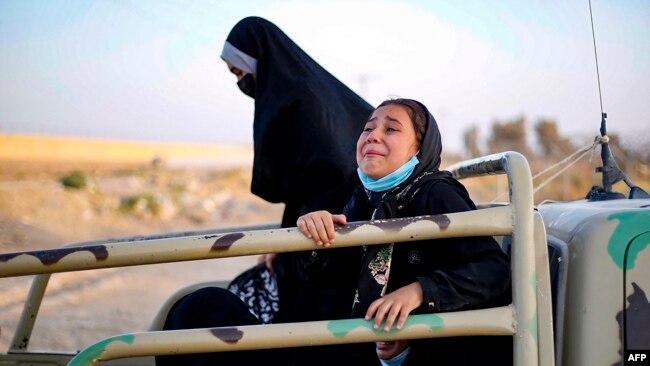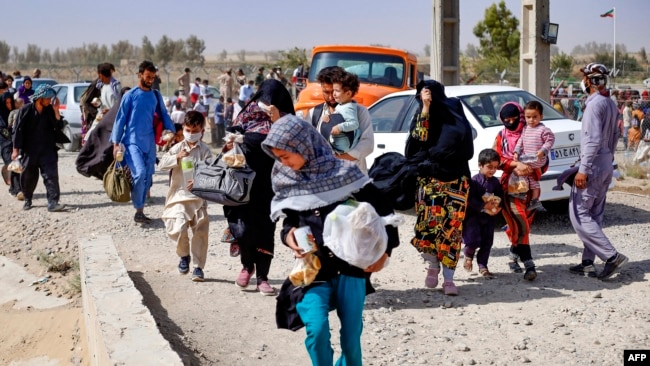VOA – A former Afghan policeman who says he is out of work under the new Taliban government is one of thousands of Afghans who have fled over the border to Iran in recent weeks.
Abdul Ahad, a 22-year-old former officer, told VOA that he is leaving the country because he “has no hope for a future” in Afghanistan.
“I lost my job, and I am forced to leave (Afghanistan) searching for a job so I can feed my family,” said Ahad, who worked for four years as a policeman in western Farah province. “I do not know what I will be doing in Iran, but at least I will be able to find a job there, earn some money and send it back to my family.”
Ahad is far from alone. Multiple sources and eyewitnesses in the border city of Zaranj, the capital of southwestern Nimruz province, have confirmed to VOA that after the Taliban’s takeover of Afghanistan, thousands of Afghans, fearing economic hardships and political persecution under the Taliban, are fleeing over the border to Iran.

An International Organization for Migration (IOM) official in Afghanistan told RFE/RL in July that up to 1.5 million Afghans could flee west in 2021 in search of “protection, safety, and jobs.”
Like many others on the road, Ahad is the breadwinner of his joint family, including his wife and son, parents and three younger brothers.
As a policeman, Ahad said that he was paid $150 (13,000 AFN) a month, which was his only income “to feed my family, but now without an income, what would my family eat.”
The World Food Program (WFP) said Thursday that 95% of Afghan families do not have enough food.
“Due to the combined effects of unemployment, a drop in the value of the local currency and a rise in prices . . . only 10 percent of families headed by someone with a secondary or university education can afford sufficient food.” said WFP, in a press release.
Fear of Reprisal
Ahad added that many of his former colleagues in the Afghan security forces had already left for Iran. “Some left because of economic problems, but others fled fearing the Taliban’s reprisal.”
The Taliban, who seized power in Afghanistan last month, pledged amnesty for government officials, but many Afghans who worked for the government remain fearful.
Human Rights Watch alleges the militant group has carried out extrajudicial killings of former government officials and security personnel.
Ahad said that he has been in Zaranj for the past 20 days.
“The route via Pakistan has been shut for the past few days. Now, we have to go to Chahar Burjak district and cross the fence at the Afghan-Iran border,” he said. “They [the smugglers] tell me that it is risky, but we take the risk because we do not have any option.”

‘Taking Risks’
Mohmmad Agha, who transports refugees and migrants to the border area with Pakistan, said that because the routes through Pakistan are shut, people cross the fence, overlooked by Iranian security towers.
“People take risks. Some are shot when they try crossing the fence, or caught inside Iran and then deported,” said Mohmmad Agha, adding that, “I have personally seen people shot, and dead bodies are brought to Afghanistan.”
He said that in recent weeks, most of the people coming to Zaranj to leave for Iran are from Afghanistan’s north.
“They are from Badakhshan, Takhar, Jawzjan and other northern provinces. Many of them are former government security personnel and officers,” Agha said.
He said Afghan migrants and refugees would go to Iran and “some will stay there,” and others would go to Turkey, and from there “they will try to go to Europe.”
Last week, Turkey warned of a new wave of Afghan refugees.
The Turkish government said last week that it cannot host more refugees and called on the international community to address the humanitarian crisis in Afghanistan so that Afghans do not flee their country.SEE ALSO:Turkey Resists Pressure to Take Afghan Refugees, Calls for Global Response
Mehrab, a local shopkeeper in Zaranj city, told VOA that the number of those coming to his city on their way to Iran, has increased ‘exponentially’ after the Taliban’s takeover.
He said that people are taking dangerous routes to leave the country.
“Smugglers usually transport Afghan migrants and refugees to the Chahar Burjak district (about 90 miles south of Zaranj), then to Pakistan, and from there to Iran,” said Mehrab, who goes by his first name, as many other Afghans.

Thousands Flee
Mehrab said people are waiting in Zaranj for the crossing routes to Pakistan to be opened so they can go to Iran.
“There is no space in the hotels. They (Afghan refugees and migrants) sleep on the streets and in front of shops and in garages,” said Mehrab. “Unlike in the past that only young Afghans would go to Iran, there are many families leaving the country.”
He added that before the closure of the crossing points to Pakistan and after the fall of Afghanistan to the Taliban, around 600 to 700 pickup trucks, each with some 20 people, would leave daily to Iran.
In videos obtained by VOA last week, a caravan of hundreds of pickup trucks, packed with men are seen departing from Zaranj city. VOA cannot independently verify the accuracy of the videos and pictures.
In a written response, David Preux, IOM emergency coordinator, said it is difficult to know how many Afghans are crossing to the neighboring countries.
“It is difficult at this point to provide accurate data on crossings into neighboring countries due to operational and security challenges,” said Preux.
IOM, however, said in July, that there was a 30 to 40% increase in the number of people leaving Afghanistan than in the previous month.
 Shabtabnews In this dark night, I have lost my way – Arise from a corner, oh you the star of guidance.
Shabtabnews In this dark night, I have lost my way – Arise from a corner, oh you the star of guidance.



